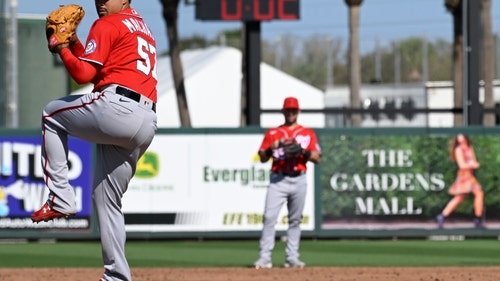
Speed Trap: At top of MLB draft, hard-throwing pitchers are dangerous-and hard to resist
The major league draft next week is expected to feature the same strategy we saw last year: teams at the top of the draft succumbing to the siren song of high school pitchers with elite velocity. Five of the first 12 picks last year were high school pitchers. Five of the first 15 this year are expected to be high school picks, including righthander and SI cover subject Hunter Greene.
Is this a smart strategy? Only if you think buying lottery tickets or hot stocks are smart. In today's velocity-mad environment, investing money, picks and years into teenagers throwing in the mid- to upper-90s without full physical maturity and with the wear and tear of showcases and travel ball—where golden arms are used the most—is especially risky.
To see if data matched my gut concern about pitchers blessed with too much velocity too soon, I checked what happened to the 92 high school pitchers drafted and signed out of the first round in the decade between 2001 and '10, allowing enough of a window to see how they turned out. The data clearly shows the high risk of using top picks on high school pitchers.
• Of the 92 high school pitchers taken in the first round from 2001 to '10, 32 of them never have pitched one game in the big leagues, a failure rate of 35%.
Think about that for a minute: A franchise has scouts all over the country and spends so much money and time to deeply evaluate hundreds of players, and when it chooses to sink all that investment into a high school pitcher, that pick will be a complete waste one out of every three times. The busts include five high school picks taken within the top 10 picks.

• Another 16 of the high school first-round picks have produced a career WAR below 1.0, which means 48 of the 92 picks made no impact. In other words, teams have been more likely to get almost nothing from a first-round high school pitcher (52%) than anything meaningful.
• The numbers are even more disastrous as you get deeper into the first round. Of the 52 first-round picks taken 21 or higher, 20 never reached the big leagues and another 21 never reached a WAR of 1.0. That's essentially no return on 79% of a decade's worth of late first-round picks.
The reward, of course, is hitting on high school pitchers such as Clayton Kershaw, Madison Bumgarner and Rick Porcello. Those are the exceptions.
As passing changed the NFL, the running back became devalued, and fewer teams drafted running backs so high. Might relief pitching be causing the same devaluation to starting pitchers, especially high school pitchers? The Dodgers, for instance, have an eight-man bullpen and multiple starters who move in and out of the rotation depending on health and workload. They've been highly successful with this model.

As I detailed in my recent book The Cubs Way, Chicago president of baseball operations Theo Epstein built his world championship team on a strategy that prioritized drafting and acquiring position players over pitchers. He knew that position players, because of health and forecast analytics, were the safer picks—the equivalent of bonds instead of stocks. The Cubs are the only franchise not to draft a pitcher within the first 30 picks in the past five drafts. In the most symbolic moment of this sea change, the Houston Astros took Stanford pitcher Mark Appel with the first pick of the 2013 draft, leaving San Diego third baseman Kris Bryant for the Cubs. Appel, who was traded to Philadelphia before the 2016 season, has never reached the majors and has a 5.20 ERA in five professional seasons. Bryant has won the Rookie of the Year and MVP awards and is a world champion.
Over the past 10 drafts, 40 first-round picks have produced a WAR of 9.0 or better. Among those successful picks, the position players outnumber the pitchers, 26-14.
So next week, be prepared to hear glowing scouting reports about high-90s velocity and high spin rates of 18-year-olds picked in the first round. A generation ago, elite high school pitchers weren't throwing this hard and they were likely to be playing other sports as well, rather than pitching competitive baseball year-round. These young guns are training like pros and in some cases already have major-league velocity. As one scouting director told me, he knows the risk, but those hard-throwing youngsters are difficult not to draft, because if he passes on a big arm for a touch-and-feel guy, the public and press will roast him. The siren song is hard to resist.






